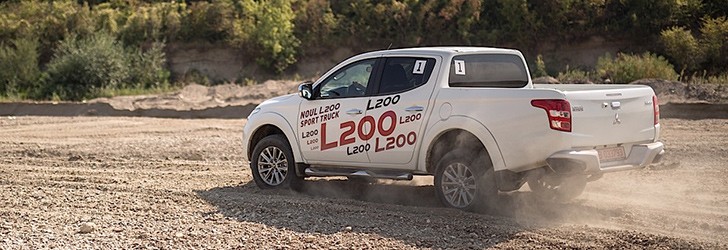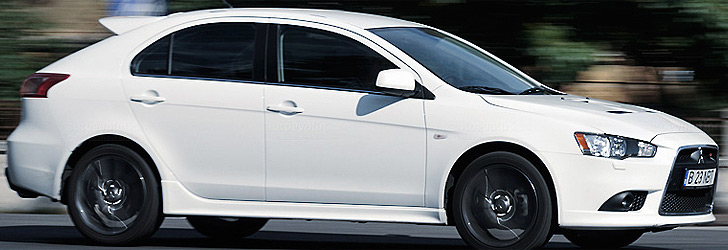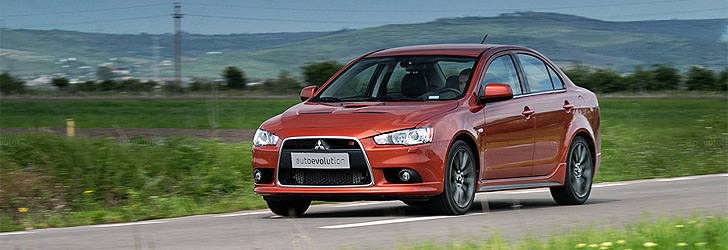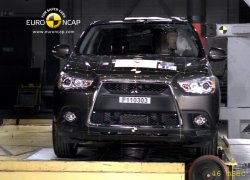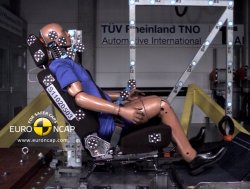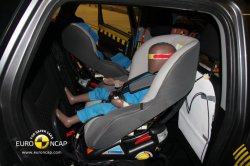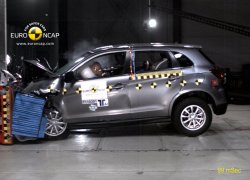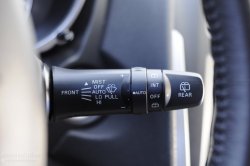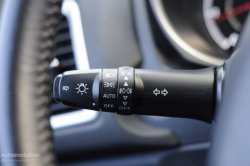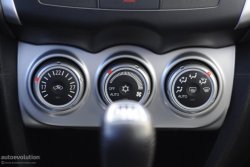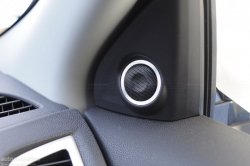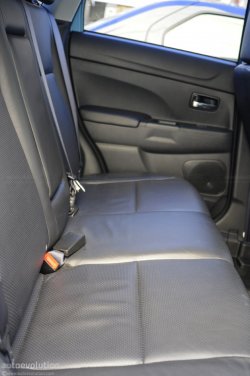MITSUBISHI ASX Review
OUR TEST CAR: MITSUBISHI ASX 1.8 DID 4WD
Mitsubishi doesn't come too often in the spotlights, but when it does, it makes people ask themselves why on Earth would anybody stay so reticent in such a crowded market when the cars it builds are so impressive. The Japanese carmaker has never called itself a leader of the automotive industry, although some of the products in its lineup pretty well managed to surprise, in a positive way, drivers from all around the world.
The Lancer Evolution is the main model that pops into one's mind when talking about Mitsubishi and the company indeed relies on the Lancer series more than on any other vehicle. But the world is changing, the economic downturn made people drop their SUVs in favor of smaller or mini cars specifically designed to achieve greater efficiency figures and thus help owners save some money usually spent on fuel. Crossovers and SUVs were undoubtedly popular, but with gas prices skyrocketing and cities becoming more crowded than ever, choosing a smaller ride was the only natural way to go into the automotive industry.
But Mitsubishi tried to innovate a little bit and launched a crossover that's able to achieve the same efficiency ratings as a compact car while maintaining the base attributes of an SUV. It is called the ASX, a model that came to be in February 2010 in Japan. It used a different name however, as Mitsubishi said from the beginning that the new crossover is specifically developed to be marketed worldwide, obviously under different names.
Regardless if it was called RVR in Japan and Canada, Outlander Sport in the United States or ASX in Europe, Mitsubishi's new model is in essence the same model all around the world, with slight modifications implemented to comply with each respective country regulations. The car is based on the cX concept presented by the Japanese brand at the 2007 Frankfurt Auto Show but also at the Tokyo Motor Show during the same year.
The ASX thus went on sale in 2010 to compete against the likes of Volkswagen Tiguan, Dacia Duster, Nissan Qashqai, Ford Kuga, Hyundai ix35, Kia Sportage and many others. Priced in between EUR 20,000 – 30,000, the new ASX promises to be much better than its competition, not only thanks to its features, but also because it's more affordable, offering one of the best price/value ratios in the class.
We wanted to see on our own if Mitsubishi's compact crossover is as powerful as its parent carmaker says it is, so we took one for a ride. Continue reading to find out our opinions on the model.
The ASX would not deserve to be part of Mitsubishi's lineup if it didn't have the “Jet Fighter” grille that basically sets apart every model designed by the Japanese carmaker. The grille is a tribute paid to Mitsubishi Heavy Industries and it's F-2 jet fighter, a feature seen on all models sold by the Japanese firm these days.
And the Jet Fighter grille is the first thing that makes bystanders pay more attention to the ASX when passing by it. The grille seems to be identical to the one of the Lancer and the Outlander, but Mitsubishi says it is different because of the bonnet edges, as it is continued with a double bulge created for increased pedestrian safety and for providing better visibility to the driver.
Not to mention that the grille is quite imposing, much like an army vehicle that makes room through enemies. And, to be honest, we tested it on our own: the other drivers on the road are freeing the lane once they see the Jet Fighter grille in their rear-view mirror. It's not like you'd be ready to smash into them, but it surely makes the others believe that you'd do it.
The ASX pretty much relies on the cX concept, but it is longer by nearly 20cm (it measures 4295mm while the concept was only 4110mm long), higher by 6.5 cm and wider by 2 cm. The overall shape of the vehicle has been refined for better efficiency and increased aerodynamics, so the car now has a 14.5 cm longer wheelbase (2670mm as compared to 2525mm on the concept) and a drag coefficient of 0.32.
At the rear, the ASX looks just like what it is supposed to be: a raised compact that retains the aggressive design lines of the front and continued by the side profile. Roof rails and optional 17-inch lightweight alloy wheels make it more SUV-ish, although the overall dimensions at the rear aren't exactly imposing.
Inside, the cozy atmosphere comes in 100 percent pure Mitsubishi style. Many of the features have already been used on the other models on the car, but we'd already got used to cost-cutting production strategies so we weren't surprised at all. Still, the interior design and the driving position seem to be much more appropriate for a crossover-like model such as the ASX rather than for sedans or hatchbacks.
The ASX makes you feel just like in a traditional SUV thanks to a high driving position and perfect visibility on the road, not only because of the large windshield, but also courtesy of huge side mirrors that let you see basically everything behind the car, including a dog that enjoys a nap on a warm manhole cover during a cold winter morning.
And, to be honest, you can't hit a dog even if you're willing to. Visibility as the rear is amazing and, if the large rear window and the big side mirrors aren't enough, the ASX also comes equipped with parking sensors and rear-view camera, obviously as optional, to make sure your friends won't call you a pet killer.
Judging by the design of the cabin, the ASX seems to be pretty stylish and elegant. Sure, there are some cheap plastics here and there but hey, it's the price that makes the car. After all, what you pay is what you get and you can't really ask for diamonds and hand-made plush for around EUR20,000.
But you still get leather seats, a large touchscreen display that provides instant access to many of the features, a tiny display in the center of the gauges that keeps you up to date with fuel consumption status, but also displays a gear shift indicator for better mileage.
Other than that, it's pretty clear that Mitsubishi's engineers have paid more attention to details, as little things seem to count the most. The chrome round module surrounding the shift lever, silver accents around the instrument panel and on the audio system speakers on the door panels, as well as leather-wrapped steering wheel and gear stick makes the ASX look like a model that would sit just fine in a higher and more expensive industry class.
As a blend of a compact car and a crossover SUV, the ASX should basically be up to whatever you feel like doing, regardless if we're discussing about the urban or the non-urban environments. But is that really true?
Probably the ace up its sleeve is fuel efficiency which today is considered a priority for most new car buyers. Equipped with a 1.8-liter diesel engine putting out 150 horsepower, our tester was more than impressive. If you're a gasoline freak but you manage to get over the tractor sound the diesel unit makes even when standing still, you'll be amazed.
Mitsubishi says this specific configuration should not exceed 4.8 l/100km (49 mpg) in city traffic but, of course, reality proves different. Not too different though, as the best we could get was around 7.2 l//100km (32.6 mpg), without being gentle at all. We pushed the throttle hard every time we needed it, so we can't really call ourselves tree huggers. Still, it's not rocket science that a more relaxed way of driving would return even better fuel consumption figures, so Mitsubishi's ratings aren't that far from the truth.
A few hours spent in heavy traffic and you'll see that the ASX has what it takes to become an excellent companion during rush hours when you have nothing to do than to wait and socialize. And, if you're the kind of guy that likes to socialize, the ASX will do nothing more than to back you up just like a friend because many eyes in the traffic jam are at first set on the car and then, unavoidably, on you.
In very rare cases when you have to spend hours in a traffic jam just because some driver tried to avoid a duck on a pedestrian crossing and hit a street lighting pole, the ASX will surely keep you busy. And entertained. It has a Start&Stop function to turn off the engine whenever you don't need it, thus boosting fuel efficiency, but also some other features to not let you get bored.
A Rockford Fosgate audio system with a total of 9 speakers streams music from either an USB, an audio CD, an MP3 player or straight from the built-in hard-disk drive that also hosts the navigation data.
Heated seats for a warm atmosphere in cold winters and an automatic air conditioning for hot summers are there to provide the perfect temperature no matter the season.
Parking shouldn't take longer than tying your shoelaces, not only because the steering system provides excellent maneuverability but also thanks to the assistance technologies such as parking sensors and rear view camera. And because the ASX was developed with an SUV in mind, its ground clearance - 8.5 in (216 mm) – allows you to climb basically on everything, so speed limiters or road kerbs are something to forget.
Although it's an SUV, the ASX seems to better enjoy the urban traffic and you'll see what we mean in a few minutes. The car gives you the feeling that you're driving an SUV, but it doesn't really act like one outside the city, mostly at higher speeds where it's pretty hard to not notice engine noise and the fact that the car becomes a little bit unstable.
The engine should be enough if you're not willing to break speed records, as the 150 horsepower developed by the engine push you to a maximum speed of 200 km/h (124 mph) but there are several reasons to stay legal.
First of all, fuel consumption. Mitsubishi ASX is one of the cars out there that burn less fuel in the city rather than outside it. Primarily, because it's a diesel, so running it at low revs is basically the easiest way to achieve low fuel consumption ratings. Driving by the gear shift indicator requires you to switch to sixth speed at around 60 km/h (37.2 mph) which proves that the 1.8-liter diesel unit is quite a flexible configuration as it supports both an efficient way of driving but also a sportier ride. Not in the last place, it has auto start-stop, which means fuel consumption is reduced especially when standing still.
Second of all, because we're dealing with a diesel engine, higher revs means increased fuel consumption. The maximum torque of 300 Nm is achieved between 2000 and 3000 rpm which means every time you exceed this barrier, you do nothing than to waste fuel.
Getting back to the way it deals with the non-urban roads, Mitsubishi says the ASX should achieve an estimated rating of about 6.7 l/100km (35.1 mpg) when driving it outside the city and the reality is not far from that. We managed to get a rating of 8.5 l/100km (27.6 mpg) and, once again, we treated the car a little bit aggressively (we know, it's the second time we handle things aggressively, but don't even think that's the way we deal with things in real life too).
The car could still become a faithful servant every time you want to cover a longer distance, as it provides a very roomy cabin, with many entertainment functions plus a spacious trunk that lets you carry all your wife's luggage.
The ASX is quite a comfy ride if you plan to stay on the legal side without breaching speed records. Still, keep in mind that it's pretty hard to ignore engine noise at higher speeds and, even if you could be used with the diesel engine “roar”, exceeding 130 km/h makes the 1.8-liter mill scream like hell.
Cruise control is there, as is the all-wheel drive system, ESP, ABS and other safety features, so safety shouldn't be a concern at all when leaving on a longer trip.
The Lancer Evolution is the main model that pops into one's mind when talking about Mitsubishi and the company indeed relies on the Lancer series more than on any other vehicle. But the world is changing, the economic downturn made people drop their SUVs in favor of smaller or mini cars specifically designed to achieve greater efficiency figures and thus help owners save some money usually spent on fuel. Crossovers and SUVs were undoubtedly popular, but with gas prices skyrocketing and cities becoming more crowded than ever, choosing a smaller ride was the only natural way to go into the automotive industry.
But Mitsubishi tried to innovate a little bit and launched a crossover that's able to achieve the same efficiency ratings as a compact car while maintaining the base attributes of an SUV. It is called the ASX, a model that came to be in February 2010 in Japan. It used a different name however, as Mitsubishi said from the beginning that the new crossover is specifically developed to be marketed worldwide, obviously under different names.
Regardless if it was called RVR in Japan and Canada, Outlander Sport in the United States or ASX in Europe, Mitsubishi's new model is in essence the same model all around the world, with slight modifications implemented to comply with each respective country regulations. The car is based on the cX concept presented by the Japanese brand at the 2007 Frankfurt Auto Show but also at the Tokyo Motor Show during the same year.
The ASX thus went on sale in 2010 to compete against the likes of Volkswagen Tiguan, Dacia Duster, Nissan Qashqai, Ford Kuga, Hyundai ix35, Kia Sportage and many others. Priced in between EUR 20,000 – 30,000, the new ASX promises to be much better than its competition, not only thanks to its features, but also because it's more affordable, offering one of the best price/value ratios in the class.
We wanted to see on our own if Mitsubishi's compact crossover is as powerful as its parent carmaker says it is, so we took one for a ride. Continue reading to find out our opinions on the model.
The ASX would not deserve to be part of Mitsubishi's lineup if it didn't have the “Jet Fighter” grille that basically sets apart every model designed by the Japanese carmaker. The grille is a tribute paid to Mitsubishi Heavy Industries and it's F-2 jet fighter, a feature seen on all models sold by the Japanese firm these days.
And the Jet Fighter grille is the first thing that makes bystanders pay more attention to the ASX when passing by it. The grille seems to be identical to the one of the Lancer and the Outlander, but Mitsubishi says it is different because of the bonnet edges, as it is continued with a double bulge created for increased pedestrian safety and for providing better visibility to the driver.
Not to mention that the grille is quite imposing, much like an army vehicle that makes room through enemies. And, to be honest, we tested it on our own: the other drivers on the road are freeing the lane once they see the Jet Fighter grille in their rear-view mirror. It's not like you'd be ready to smash into them, but it surely makes the others believe that you'd do it.
The ASX pretty much relies on the cX concept, but it is longer by nearly 20cm (it measures 4295mm while the concept was only 4110mm long), higher by 6.5 cm and wider by 2 cm. The overall shape of the vehicle has been refined for better efficiency and increased aerodynamics, so the car now has a 14.5 cm longer wheelbase (2670mm as compared to 2525mm on the concept) and a drag coefficient of 0.32.
At the rear, the ASX looks just like what it is supposed to be: a raised compact that retains the aggressive design lines of the front and continued by the side profile. Roof rails and optional 17-inch lightweight alloy wheels make it more SUV-ish, although the overall dimensions at the rear aren't exactly imposing.
Inside, the cozy atmosphere comes in 100 percent pure Mitsubishi style. Many of the features have already been used on the other models on the car, but we'd already got used to cost-cutting production strategies so we weren't surprised at all. Still, the interior design and the driving position seem to be much more appropriate for a crossover-like model such as the ASX rather than for sedans or hatchbacks.
The ASX makes you feel just like in a traditional SUV thanks to a high driving position and perfect visibility on the road, not only because of the large windshield, but also courtesy of huge side mirrors that let you see basically everything behind the car, including a dog that enjoys a nap on a warm manhole cover during a cold winter morning.
And, to be honest, you can't hit a dog even if you're willing to. Visibility as the rear is amazing and, if the large rear window and the big side mirrors aren't enough, the ASX also comes equipped with parking sensors and rear-view camera, obviously as optional, to make sure your friends won't call you a pet killer.
Judging by the design of the cabin, the ASX seems to be pretty stylish and elegant. Sure, there are some cheap plastics here and there but hey, it's the price that makes the car. After all, what you pay is what you get and you can't really ask for diamonds and hand-made plush for around EUR20,000.
But you still get leather seats, a large touchscreen display that provides instant access to many of the features, a tiny display in the center of the gauges that keeps you up to date with fuel consumption status, but also displays a gear shift indicator for better mileage.
Other than that, it's pretty clear that Mitsubishi's engineers have paid more attention to details, as little things seem to count the most. The chrome round module surrounding the shift lever, silver accents around the instrument panel and on the audio system speakers on the door panels, as well as leather-wrapped steering wheel and gear stick makes the ASX look like a model that would sit just fine in a higher and more expensive industry class.
As a blend of a compact car and a crossover SUV, the ASX should basically be up to whatever you feel like doing, regardless if we're discussing about the urban or the non-urban environments. But is that really true?
Probably the ace up its sleeve is fuel efficiency which today is considered a priority for most new car buyers. Equipped with a 1.8-liter diesel engine putting out 150 horsepower, our tester was more than impressive. If you're a gasoline freak but you manage to get over the tractor sound the diesel unit makes even when standing still, you'll be amazed.
Mitsubishi says this specific configuration should not exceed 4.8 l/100km (49 mpg) in city traffic but, of course, reality proves different. Not too different though, as the best we could get was around 7.2 l//100km (32.6 mpg), without being gentle at all. We pushed the throttle hard every time we needed it, so we can't really call ourselves tree huggers. Still, it's not rocket science that a more relaxed way of driving would return even better fuel consumption figures, so Mitsubishi's ratings aren't that far from the truth.
A few hours spent in heavy traffic and you'll see that the ASX has what it takes to become an excellent companion during rush hours when you have nothing to do than to wait and socialize. And, if you're the kind of guy that likes to socialize, the ASX will do nothing more than to back you up just like a friend because many eyes in the traffic jam are at first set on the car and then, unavoidably, on you.
In very rare cases when you have to spend hours in a traffic jam just because some driver tried to avoid a duck on a pedestrian crossing and hit a street lighting pole, the ASX will surely keep you busy. And entertained. It has a Start&Stop function to turn off the engine whenever you don't need it, thus boosting fuel efficiency, but also some other features to not let you get bored.
A Rockford Fosgate audio system with a total of 9 speakers streams music from either an USB, an audio CD, an MP3 player or straight from the built-in hard-disk drive that also hosts the navigation data.
Heated seats for a warm atmosphere in cold winters and an automatic air conditioning for hot summers are there to provide the perfect temperature no matter the season.
Parking shouldn't take longer than tying your shoelaces, not only because the steering system provides excellent maneuverability but also thanks to the assistance technologies such as parking sensors and rear view camera. And because the ASX was developed with an SUV in mind, its ground clearance - 8.5 in (216 mm) – allows you to climb basically on everything, so speed limiters or road kerbs are something to forget.
Although it's an SUV, the ASX seems to better enjoy the urban traffic and you'll see what we mean in a few minutes. The car gives you the feeling that you're driving an SUV, but it doesn't really act like one outside the city, mostly at higher speeds where it's pretty hard to not notice engine noise and the fact that the car becomes a little bit unstable.
The engine should be enough if you're not willing to break speed records, as the 150 horsepower developed by the engine push you to a maximum speed of 200 km/h (124 mph) but there are several reasons to stay legal.
First of all, fuel consumption. Mitsubishi ASX is one of the cars out there that burn less fuel in the city rather than outside it. Primarily, because it's a diesel, so running it at low revs is basically the easiest way to achieve low fuel consumption ratings. Driving by the gear shift indicator requires you to switch to sixth speed at around 60 km/h (37.2 mph) which proves that the 1.8-liter diesel unit is quite a flexible configuration as it supports both an efficient way of driving but also a sportier ride. Not in the last place, it has auto start-stop, which means fuel consumption is reduced especially when standing still.
Second of all, because we're dealing with a diesel engine, higher revs means increased fuel consumption. The maximum torque of 300 Nm is achieved between 2000 and 3000 rpm which means every time you exceed this barrier, you do nothing than to waste fuel.
Getting back to the way it deals with the non-urban roads, Mitsubishi says the ASX should achieve an estimated rating of about 6.7 l/100km (35.1 mpg) when driving it outside the city and the reality is not far from that. We managed to get a rating of 8.5 l/100km (27.6 mpg) and, once again, we treated the car a little bit aggressively (we know, it's the second time we handle things aggressively, but don't even think that's the way we deal with things in real life too).
The car could still become a faithful servant every time you want to cover a longer distance, as it provides a very roomy cabin, with many entertainment functions plus a spacious trunk that lets you carry all your wife's luggage.
The ASX is quite a comfy ride if you plan to stay on the legal side without breaching speed records. Still, keep in mind that it's pretty hard to ignore engine noise at higher speeds and, even if you could be used with the diesel engine “roar”, exceeding 130 km/h makes the 1.8-liter mill scream like hell.
Cruise control is there, as is the all-wheel drive system, ESP, ABS and other safety features, so safety shouldn't be a concern at all when leaving on a longer trip.
12
Our MITSUBISHI Testdrives:
Photo gallery (97)

